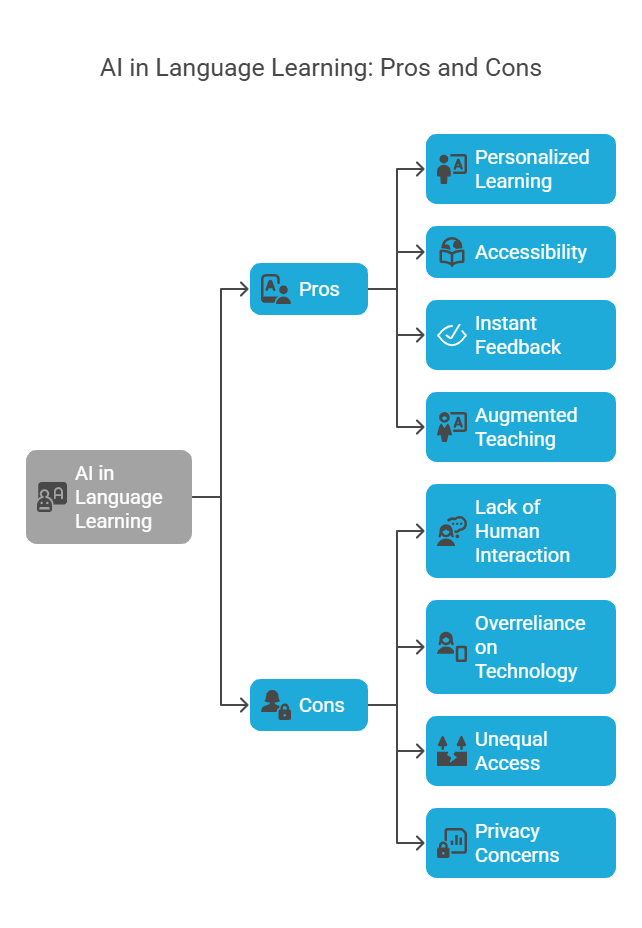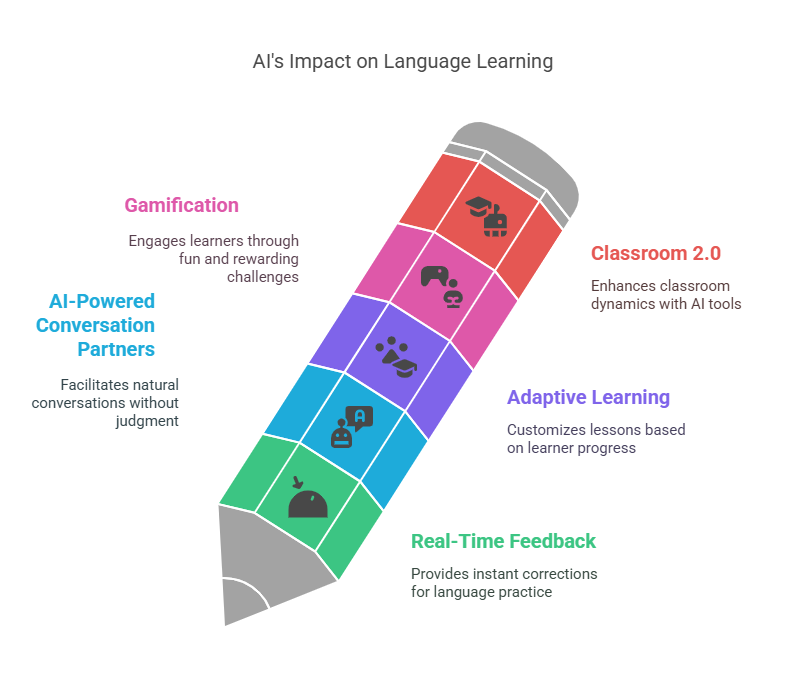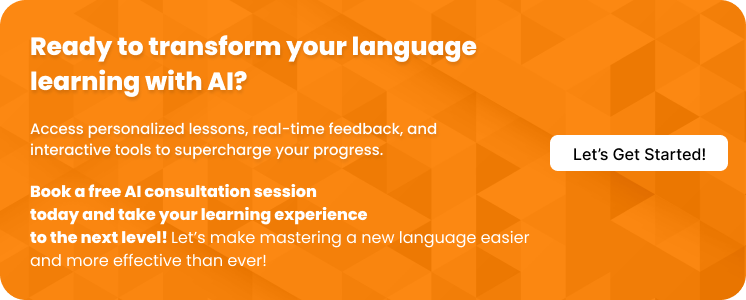In this AI era, language learning is no longer limited to textbooks and traditional classrooms. With the rise of Artificial Intelligence (AI), learning a new language has become smarter, faster, and more personalized than ever before. AI language learning tools are taking the guesswork out of mastering a new language, offering real-time feedback, customized lessons, and even speech recognition to help learners improve their pronunciation and fluency.
AI isn’t just automating processes–it’s transforming the learning experience. Imagine an AI-powered app that listens to your speech, corrects your pronunciation instantly, and customizes lessons based on your strengths and weaknesses.
The global AI language learning market is projected to reach $2.1 billion by 2027, growing at a 15% compound annual growth rate (CAGR). That’s a clear sign that AI is not just a trend but a game-changer in education.
So, why is AI making such a huge impact in language learning? For starters, it allows for a more interactive, flexible, and engaging learning environment. Learners can practice anytime, anywhere, and receive immediate feedback.
In this blog, we will discover how AI is reshaping the language learning experience, the latest innovations in AI language tools, and why this technology is the future of language learning.
The Impact of AI on Language Learning
Artificial Intelligence (AI) has quickly become a powerful tool in language learning. From enhancing educational methods to providing personalized learning experiences, AI solutions are incredibly valuable for learners, educators, and businesses.
While AI brings many benefits, such as improving accessibility and efficiency in language learning, it also presents challenges. A Microsoft survey found that many institutions see AI as key to boosting their competitiveness, innovation, and overall success.
As the conversation around AI in language learning grows, it’s important to consider both its advantages and potential drawbacks.

Pros.
1) Personalized Learning
AI-powered language learning platforms can understand each learner’s strengths, weaknesses, learning speed, and preferences. Using this information, they create a custom learning path that keeps learners engaged and helps them more effectively reach their goals.
2) Accessible
AI language tools allow learners to access lessons, exercises, and tutoring anytime, anywhere. This flexibility breaks down barriers, especially for learners with special needs.
For example, AI can summarize content, suggest easier words, or make tasks more understandable, helping students learn more easily.
3) Instant Feedback
AI can give learners quick feedback on their pronunciation, grammar, and vocabulary. This lets them spot and fix mistakes right away, speeding up their learning. Advanced voice recognition technology helps AI understand the learner’s pronunciation and accent, so the feedback is accurate. With real-time analysis, AI suggests corrections that are easy to follow and apply, allowing learners to focus on other tasks without worrying about waiting for feedback.
4) Augmented Teaching
AI tools help teachers by improving traditional teaching methods. They assist with creating lessons, tracking student progress, and spotting areas that require more focus. This makes teaching more effective and enjoyable for both teachers and students while also reducing teachers’ workloads.
Cons.
1) Lack of Human Interaction
One of AI’s main limitations in language learning is that it can’t replace real human interaction. Learning a language involves more than just words—it includes cultural differences and small communication signals that AI may not fully understand. Right now, AI can’t offer the same immersive experience as speaking with a real person.
While AI tools like Google’s Bard are experimenting with conversations, AI is still not fully capable of having natural, flowing conversations. It will improve over time, but for now, its ability to help in real-language situations is limited.
2) Plagiarism and Overreliance
If learners depend too heavily on AI tools, it can affect their ability to think independently and solve problems. Overusing technology might also limit their creativity and ability to handle real-life situations in a language. Additionally, teachers may face issues with students submitting assignments that were written by AI.
To address this, schools will need systems to detect AI-generated work. As AI continues to improve, so will these plagiarism-checking systems, creating an ongoing challenge to keep up.
3) Unequal Access/Resources
Not all learners have the same access to AI tools, which could create a learning gap. While some schools have the resources to invest in advanced AI systems, others don’t. This means students in schools with fewer resources may miss out on the benefits of AI learning tools, making it harder for them to keep up with others.
Though technology tends to become cheaper over time, schools in poorer areas may still be stuck with outdated tools that are not as effective or easy to use.
4) Privacy and Ethics
AI-powered language learning platforms collect a lot of personal data from users. Many people are concerned about how their data is being used whether it’s secure from potential threats, and how it’s being ethically handled. As AI becomes more involved in everyday learning, more data is needed for it to work well, which means better security systems must be in place to protect users’ information.
Countries are starting to introduce laws to ensure AI is used safely and ethically, and these laws will need to continue evolving as AI technology develops.
How AI is Revolutionizing the Way We Learn
From real-time corrections to personalized lessons, AI language learning is transforming how we approach language learning. Let’s dive into how AI is changing the language learning game.

1) Real-Time Feedback: Instant Corrections, Instant Improvement
Imagine this:
You’re practicing your new language, and when you mispronounce a word, an app gently corrects you. No waiting for feedback, no guessing if you got it right. That’s the power of real-time feedback in AI language learning!
AI language tools catch your mistakes in real time, helping you fix them instantly and keep your learning on track. No more waiting for feedback—just quick, personalized corrections to boost your progress fast!
Pro Tip: Apps with advanced speech recognition help you fine-tune your pronunciation, making your speech more natural and fluent. Perfect for practicing at home or while traveling!
2) AI-Powered Conversation Partners: Speak Like a Native
Learning a language isn’t just about memorizing words—it’s about real conversations. But what if you don’t have someone to practice with? That’s where AI-powered conversation partners come in.
Imagine chatting with an AI bot that sounds like a real person—no awkward pauses, no judgment, just smooth conversation. These AI language bots are designed to help you practice anytime, anywhere. As you progress, the bots get smarter and adapt to your learning level, making you feel like you have a native speaker available 24/7.
3) Adaptive Learning: Customized Lessons to Fit Your Needs
Forget the old “one-size-fits-all” approach. AI takes personalized learning to the next level with adaptive learning platforms that customize lessons based on your strengths and weaknesses.
AI algorithms track your progress and adapt lessons in real time. Struggling with grammar? You’ll get extra exercise.
Mastered basic vocabulary? AI-powered learning apps will introduce more advanced topics, helping you progress efficiently.
This personalized learning path allows you to progress at your own pace and more efficiently than ever before.
4) Gamification: Learning Through Play
Learning a language doesn’t have to be hard. With AI-powered apps, it’s fun and gamified—think interactive quizzes, daily challenges, and points that keep you motivated!
What makes gamification so effective?
It adds excitement and makes practice feel less like a chore. AI tracks your progress in real time and adjusts difficulty levels based on your performance, so you’re constantly challenged without getting overwhelmed.
5) Classroom 2.0: How AI Enhances Traditional Learning
AI language learning is not just for individual learners. It’s also transforming classrooms around the world. Teachers can use AI-powered tools to personalize lessons, track progress, and even automate tasks like grading.
These tools enhance traditional teaching methods by making lessons more interactive and efficient. AI in education can suggest extra resources, recommend practice exercises, and provide feedback, all while helping teachers save time on administrative tasks.
Imagine AI as the assistant every teacher dreams of—enhancing the classroom experience for both students and educators.
The Future: What’s Next for AI Language Learning?
There’s so much more AI can do for language learning that we haven’t even explored yet. In the coming years, AI could become even smarter, understanding emotions, cultural context, and the small details of conversation we never imagined.

What can we expect next?
- Emotion-aware AI: Imagine AI that can sense how you’re feeling—whether you’re frustrated or excited—and adjust lessons to make learning easier and more fun.
- Immersive AR/VR Experiences: Practice speaking in real-life situations, like chatting in a virtual café in Paris, making learning feel like an adventure.
- Cultural and Regional Learning: AI will help you learn not just the language but also cultural details and local variations, giving you a deeper understanding than any textbook.
The future of AI in language learning offers exciting opportunities, and we are eager to see what happens next!
Conclusion
So, what’s next? One thing is certain: AI is completely transforming how we learn languages! From instant feedback and lessons that fit you to gamified challenges and virtual chats, AI is making learning faster, more fun, and way more effective.
As technology keeps growing, the possibilities for language learning are endless. Whether you’re a beginner or looking to fine-tune your skills, AI-powered tools are your ultimate language-learning companion.
So, why wait? Dive into the future of language learning—it’s all at your fingertips, making your journey unforgettable!

I just like the helpful info you provide on your articles.
I will bookmark your blog and take a look at again here regularly.
I’m reasonably sure I’ll be informed lots of new stuff right right here!
Best of luck for the following!
Thank you so much for your kind words and support! I’m really glad you found the information helpful. 😊
Feel free to drop by anytime—there’s always new content on the way, and I’d love to hear your thoughts. Thanks again for bookmarking the blog!